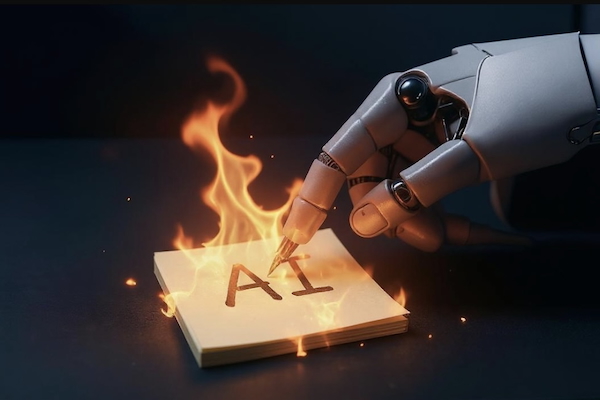 Credit: Steven Miller
Credit: Steven Miller
As the world burns under the ever-growing effects of climate change, the burgeoning use of power-hungry artificial intelligence (AI) in both business and everyday life is set to increase power usage, water consumption and pollution worldwide, at the worst possible time.
We are being sold AI on the premise that it will reshape the world and provide us all with a form of technological convenience beyond our wildest dreams. But as the technology takes on the heavy lifting of everyday computational processes and is incorporated into all levels of administration, education, entertainment and life in general, we need to ask, at what price?
The answer is a price not measured in currency terms, stakeholder value or growth percentages but in terawatts and water.
The energy, power and water consumption involved in training and deploying AI systems is significant and growing. Training AI’s Large Language Models (LLMs), providing responses to users and supporting the infrastructure behind the technology will become more efficient over time but this efficiency is unlikely to arrive soon or be sufficient enough to curb the increase in energy required as AI adoption skyrockets as it becomes an integral part of our everyday existence in the way its developers say it will.
Not all AI systems are created equally. Some use more energy (and subsequently water) than others and these are still relatively early stage AI systems which rely on data prediction. Agentive AI - systems that can autonomously perceive, decide and act to achieve specific goals - and Artificial General Intelligence (AGI) – AI systems with the ability to understand, learn and apply knowledge across a wide range of tasks at a level comparable to humans - will likely require even greater levels of energy to function.
There is a common argument that AI will itself be able to identify and enact efficiencies in its code to reduce power consumption, but that is currently an assumption with no delivery timescale. For now, we’re burning the fields hoping that the fire will make the ground more fertile. By the time these advertised efficiencies arrive, we may have passed a tipping point no efficiency can reverse and no self-aware AI system will be interested in pursuing.
Beyond improving the technology itself, through coding and hardware improvements, current suggestions for curbing AI’s energy usage have included the restarting of decommissioned nuclear power plants, utilising more renewable energy sources, moving data centres to colder locations (including underwater), introducing decentralisation to reduce data transmission costs and implementing energy scheduling to limit AI processing to off-peak hours.
All of these are viable options but each comes at a price. The commandeering of nuclear facilities and use of renewable energy sources removes the availability of these much needed alternative energy sources from the already struggling energy transition programmes needed to reduce energy consumption from industry, transport, infrastructure and agriculture.
The building of a nuclear power station can take on average between eight to fifteen years, without factoring in any bureaucratic issues. Renewable energy infrastructure relies on rare-earth materials to build wind turbine generators, electric vehicle batteries, photovoltaics cells for solar panels and semiconductors and diodes for LED lights. The extraction of these materials is already being used as a bargaining chip in trade and arms deals. Their scarcity gives them significant value. Their extraction yields a heavy price on the environment. If AI infrastructure continues to grow at its current rate, the race to secure and extract these materials will only increase with it and existing efforts to use them for the benefit of reducing our already high levels of energy consumption will surely suffer.
Yet this is nothing new. Technologies such as the internet and blockchain have, for decades now, been consuming ever growing amounts of energy. With the advent of cloud computing and streaming, the availability of high-bandwidth, always-on data connections has become a necessity, not just in business but in the living room, on the go and anywhere one travels with a connected device. The number of internet-connected devices has only added to this.
Once regarded as a realm for computers, the online world now serves everything from security cameras to fridge-freezers. The rise in popularity of blockchain-powered technologies such as cryptocurrencies, non-fungible tokens (NFTs), decentralised banking, tokenised assets, digital supply chain management, document management and other decentralised services all require a continuous, uninterrupted supply of power. Estimates place blockchain’s energy consumption rate at around 100 to 150 terawatts (TWh) per year. AI systems currently use around 50 to 100 TWh per year. To put that into perspective, 100 TWh is the equivalent of the UK’s total electrical power consumption over an eighteen month period. It’s enough to power 30 million homes across the European Union for three years.
A modern nuclear power station can generate approximately 7.9 TWh of electricity per year. Add in the exponential uptake of AI (alongside the growing use of blockchain technologies) and an estimated worldwide population growth of 580 million people in the next ten years and you don’t have to be a genius to understand that, at the current rate of development, we need to learn how to build a very large number of nuclear reactors very quickly and source a massive amount of rare-earth minerals to even make a dent in the energy requirements of AI alone.
As record temperatures are recorded across the planet, as rivers dry up and droughts take hold across continents, how does human intelligence not understand that placing all bets on a water guzzling, carbon-producing monster like AI is an incredibly bad idea? Are we so blinded by the snake oil salesman who proclaim AI will be the panacea to all of the environment problems humans have created that we’ve failed to realise that AI may well realise that what happens to the environment is not a problem for its survival - only ours.
The good news is that maybe there’s no real need to fear AI sending in the Terminators to wipe out humanity because we’re doing a pretty fine job of ensuring the planet will do that job for it.
This is the second in an ongoing series of articles looking at different aspects of AI. The first article can be found here.








